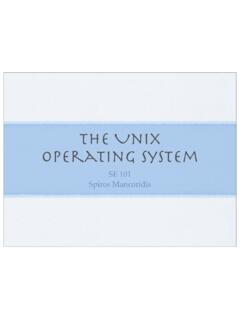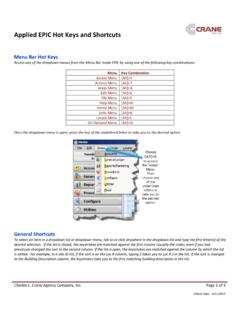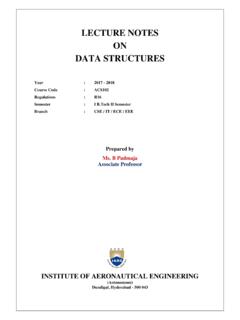Transcription of Algorithms pseudocode; examples - Gabriel Istrate
1 Algorithmics - Lecture 21 LECTURE 2: Algorithms pseudocode ; examples Algorithmics - Lecture 22 Organizational: Webpage: up and running. Newsgroup: algouvt on yahoo groups. Please subscribe. First homework: posted tomorrow on the webpage. DEADLINE (firm): Friday, October 19, 5pm. Algorithmics - Lecture 23 Outline Continue with Algorithms / pseudocode from last time. Describe some simple Algorithms Decomposing problems in subproblems and Algorithms in subalgorithmsAlgorithms - Lecture 14 Properties an algorithm should have Generality Finiteness Non-ambiguity EfficiencyAlgorithms - Lecture 15 EfficiencyAn algorithm should use a reasonable amount of computing resources: memory and timeFiniteness is not enough if we have to wait too much to obtain the resultExample: Consider a dictionary containing 50000 words. Write an algorithm that takes a word as input and returns all anagrams of that word appearing in the dictionary. Example of anagram: ship -> hipsAlgorithms - Lecture 16 EfficiencyFirst approach:Step 1: generate all anagrams of the word Step 2: for each anagram search for it in the dictionary (using binary search)Let s consider that: the dictionary contains n words the analyzed word contains m letters Rough estimate of the number of basic operations: number of anagrams: m!
2 Words comparisons for each anagram: log2n ( binary search) letters comparisons for each word: m m!* m*log2n Algorithms - Lecture 17 EfficiencySecond approach: Step 1: sort the letters of the initial word Step 2: for each word in the dictionary having m letters: sort the letters of this word Compare the sorted version of the word with the sorted version of the original wordRough estimate of the number of basic operations: Sorting the initial word needs almost m2 operations ( insertion sort ) Sequentially searching the dictionary and sorting each word of length m needs at most nm2 comparisons Comparing the sorted words requires at most nm comparisonsn m2 +nm+ m2 Algorithms - Lecture 18 EfficiencyFirst approachSecond approachm! m log2n n m2 +n m+ m2 Example: m=12 ( word algorithmics) n=50000 (number of words in dictionary) 8* 10^108*10^6 one basic operation ( )= 1ms=10-3 s24000 hours2 hoursThus, important to analyze efficiency and choose more efficient algorithmsWhich approach is better ?
3 Algorithms - Lecture 19 Outline Problem solving What is an algorithm ? Properties an algorithm should have Describing Algorithms Types of data to use Basic operations Algorithms - Lecture 110 How can we describe Algorithms ? Solving problems can usually be described in mathematical languageNot always adequate to describe Algorithms because: Operations which seem elementary when described in a mathematical language are not elementary when they have to be encoded in a programming languageExample: computing a sum, computing the value of a polynomial i=1ni=1+2+..+nMathematical descriptionAlgorithmic description (it should be a sequence of basic operations) Algorithms - Lecture 111 How can we describe Algorithms ?Two basic instruments: Flowcharts: graphical description of the flow of processing steps not used very often, somewhat old-fashioned. however, sometimes useful to describe the overall structure of an application pseudocode : artificial language based on vocabulary (set of keywords) syntax (set of rules used to construct the language s phrases ) not as restrictive as a programming languageAlgorithms - Lecture 112 Why do we call it pseudocode ?
4 Because .. It is similar to a programming language (code) Not as rigorous as a programming language (pseudo)In pseudocode the phrases are: Statements or instructions (used to describe processing steps) Declarations (used to specify the data) Algorithms - Lecture 113 Types of dataData = container of informationCharacteristics: name value constant (same value during the entire algorithm) variable (the value varies during the algorithm) type primitive (numbers, characters, truth values ..) structured (arrays) Algorithms - Lecture 114 Types of dataArrays - used to represent: Sets ( {3,7,4}={3,4,7}) the order of the elements doesn t matter Sequences ( (3,7,4) is not (3,4,7)) the order of the elements matters Matrices bidimensional arrays 73410013 7 4 Index: 1 2 31100(1,1)(1,2)(2,1)(2,2) Algorithms - Lecture 115 How can we specify data ? Simple data: IntegersINTEGER <variable> RealsREAL <variable> BooleanBOOLEAN <variable> CharactersCHAR <variable> Algorithms - Lecture 116 How can we specify data ?
5 ArraysOne dimensional<elements type> <name>[ ] (ex: REAL x[ ])Two-dimensional <elements type> <name>[ , ] (ex: INTEGER A[ , ]) Algorithms - Lecture 117 How can we specify data ?Specifying elements: One dimensionalx[i] - i is the element s index Two-dimensional A[i,j] - i is the row s index, while j is the column s indexAlgorithms - Lecture 118 How can we specify data ?Specifying subarrays: Subarray= contiguous portion of an array One dimensional: x[ ] (1<=i1<i2<=n) Bi dimensional: A[ , ] (1<=i1<i2<=m, 1<=j1<j2<=n)1ni2i1m1i21nj1j2i1 Algorithms - Lecture 119 Outline Problem solving What is an algorithm ? Properties an algorithm should have Describing Algorithms Types of data to use Basic instructions Algorithms - Lecture 120 What are the basic instructions ?Instruction (statement) = action to be executed by the algorithmThere are two main types of instructions: Simple Assignment (assigns a value to a variable) Transfer (reads an input data; writes a result) Control (specifies which is the next step to be executed) Structured.
6 Algorithms - Lecture 121 Aim: give a value to a variable Description: v <expression> Rmk: sometimes we use := instead of Expression = syntactic construction used to describe a computationIt consists of: Operands: variables, constant values Operators: arithmetical, relational, logical AssignmentAlgorithms - Lecture 122 Arithmetical:+ (addition), - (subtraction), *(multiplication), / (division), ^ (power), DIV (from divide) or / (integer quotient), MOD (from modulo) or % (remainder) Relational:= (equal), != (different), < (less than), <= (less than or equal),>(greater than) >= (greater than or equal) Logical: OR (disjunction), AND (conjunction), NOT (negation) OperatorsAlgorithms - Lecture 123 Input/Output Aim: read input data output the results Description: read v1,v2,.. input v1, v2,.. write e1,e2,.. print e1, e2,..23useruserVariables of the algorithmread (input)write (print)InputOutputAlgorithms - Lecture 124 Instructions Structured: Sequence of instructions Conditional statement Loop statementAlgorithms - Lecture 125conditioncondition<S1> <S2> <S>TrueFalseTrueFalseConditional statement Aim: choosing between two or several alternatives depending on the value of some conditions General variant:if <condition> then <S1> else <S2>endif Simplified variant:if <condition> then <S>endif Algorithms - Lecture 126 Loop statements Aim: repeating a processing step Example: compute a sum S= 1+2+.
7 +i+..+n Characterized by: Processing step which have to be repeated Stopping (or continuation) condition Depending on the moment of analyzing the stopping condition there are two main loop statements: Preconditioned loops (WHILE loops) Postconditioned loops (REPEAT loops) Algorithms - Lecture 127<condition> <statement>NextstatementFalseTruewhile <condition> do <statement>endwhileWHILE loop First, the condition is analyzed If it is true then the statement is executed and the condition is analyzed again If the condition becomes false the control of execution passes to the next statement in the algorithm If condition never becomes false then the loop is infinite If the condition is false from the beginning then the statement inside the loop is never executedAlgorithms - Lecture 128<condition> <statement>NextstatementFalseTruewhile <condition> do <statement>endwhileWHILE loopS:=0 // initialize the variable which will // contain the resulti:=1 // index intializationwhile i<=n do S:=S+i // add the current term to S i:=i+1 // prepare the next termendwhile i=1ni=1+2+.
8 +nAlgorithms - Lecture 129 FOR loop Sometimes the number of repetitions of a processing step is known apriori Then we can use a counting variable which varies from an initial value to a final value using a step value Repetitions: v2-v1+1 if step=1 v <= v2<statement>NextstatementFalseTruefor v:=v1,v2,step do <statement>endfor v:=v+step v:=v1v:=v1while v<=v2 do<statement>v:=v+stependwhileAlgorithms - Lecture 130 FOR loop v <= v2<statement>NextstatementFalseTruefor v:=v1,v2,step do <statement>endfor v:=v+step v:=v1S:=0 // initialize the variable which will // contain the resultfor i:=1,n do S:=S+i // add the term to Sendfor i=1ni=1+2+..+nAlgorithms - Lecture 131 REPEAT loop First, the statement is executed. Thus it is executed at least once Then the condition is analyzed and if it is false the statement is executed again When the condition becomes true the control passes to the next statement of the algorithm If the condition doesn t become true then the loop is infinite <condition> <statement>NextstatementTruerepeat <statement>until <condition> Algorithms - Lecture 132 REPEAT loop <condition> <statement>NextstatementTruerepeat <statement>until <condition> S:=0 i:=1repeat S:=S+i i:=i+1until i>n i=1ni=1+2+.
9 +nS:=0 i:=0repeat i:=i+1 S:=S+iuntil i>=n Algorithms - Lecture 133 REPEAT loopAny REPEAT loop can be transformed in a WHILE loop:<statement>while NOT <condition> DO<statement>endwhile <condition> <statement>NextstatementTruerepeat <statement>until <condition> Algorithms - Lecture 134 Summary Algorithms are step-by-step procedures for problem solving They should have the following properties: Generality Finiteness Non-ambiguity (rigorousness) Efficiency Data processed by an algorithm can be simple structured ( arrays) We describe Algorithms by means of pseudocodeAlgorithms - Lecture 135 Summary pseudocode :Assignment :=Data transfer read (input), write (print)Decisions if .. then .. else .. endifLoops while .. do .. endwhile for .. do .. endfor repeat .. until Algorithmics - Lecture 236 Example 1 Consider a table containing info about student results : fill in the status and average fields such thatstatus = 1 if ECTS=60status= 2 if ECTS belongs to [30,60)status= 3 if ECTS<30 the average is computed only if ECTS=60 Algorithmics - Lecture 237 Example 1 The filled table should look like - Lecture 238 Example 1 What kind of data should we process ?]
10 Data: marks and ECTS marks[ , ] : two dimensional array (matrix) with 5 rows and 3 columnsPseudocode specification: integer marks[ , ]Algorithmics - Lecture 239 Example 1 What kind of data should we process ? data: marks and ECTS ects[ ] : one-dimensional array with 5 elementsPseudocode specification: integer ects[ ]Algorithmics - Lecture 240 Example 1 What kind of data should we process ? data: status and averagestatus[ ], average[ ] : one-dimensional arrays with 5 elements pseudocode specification: integer status[ ] real average[ ]Algorithmics - Lecture 241 Example 1 Rule to fill in the status of a studentstatus = 1 if ECTS=60status= 2 if ECTS belongs to [30,60)status= 3 if ECTS<30ects=60 pseudocode description:if ects=60 then status 1 else if ects>=30 then status 2 else status 3 endifendifstatus 1yesects>=30status 2status 3nonoyesPython descriptionif ects==60:status=1elif ects>=30:status=2else:status=3 Algorithmics - Lecture 2 Example 1 Filling in the status of all students: for each student fill in the status fieldRemark: Let us denote with n the number of students (in our example n=5)Step 1: start from the first element (i:=1)Step 2: check if there are still elements to process (i<=n).]





